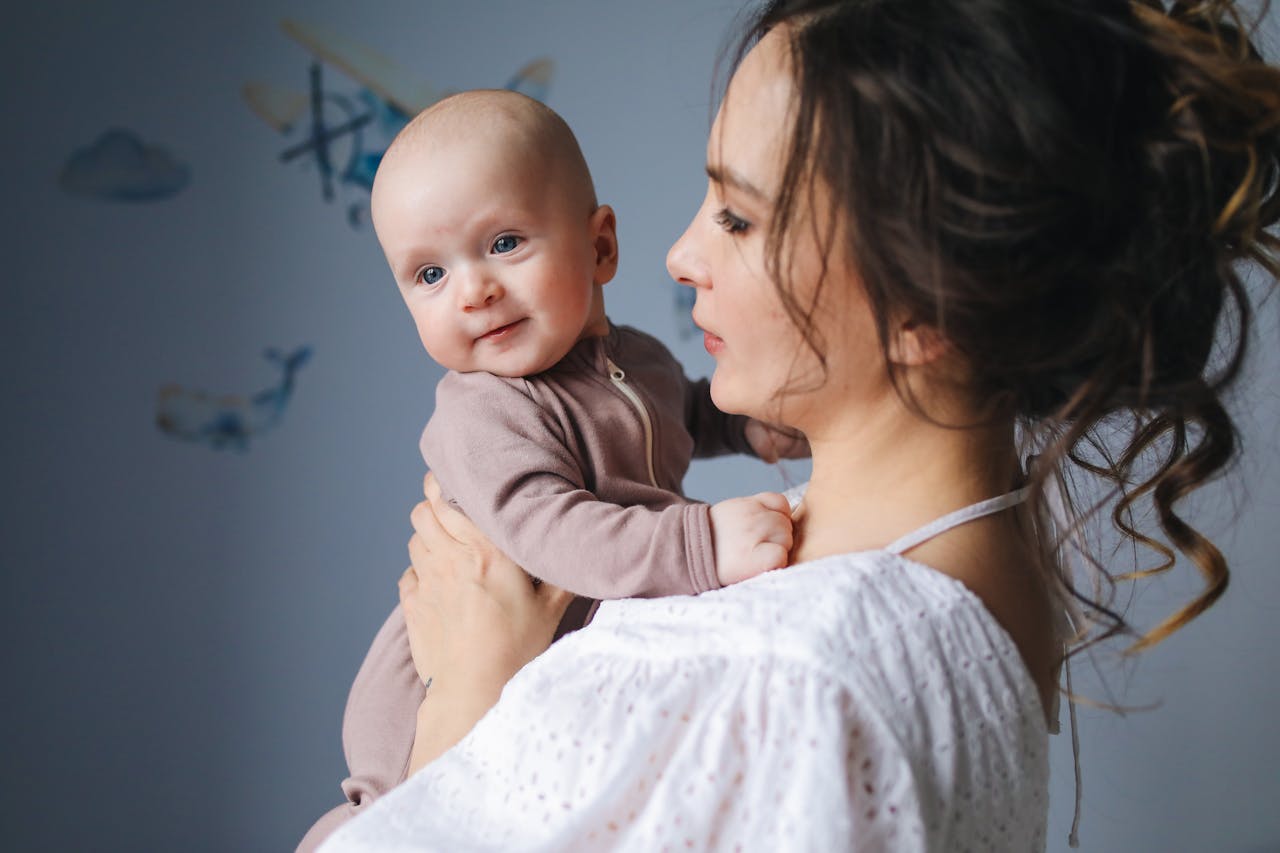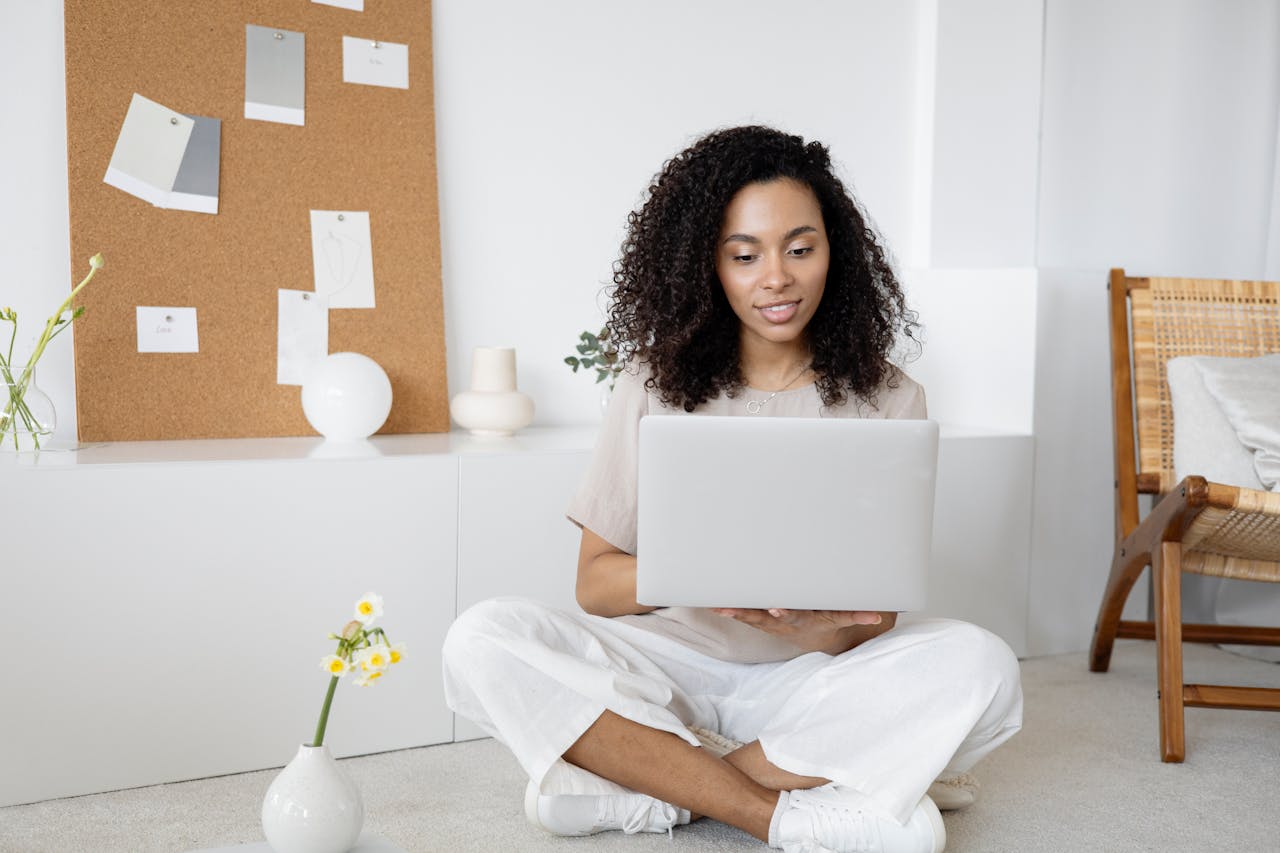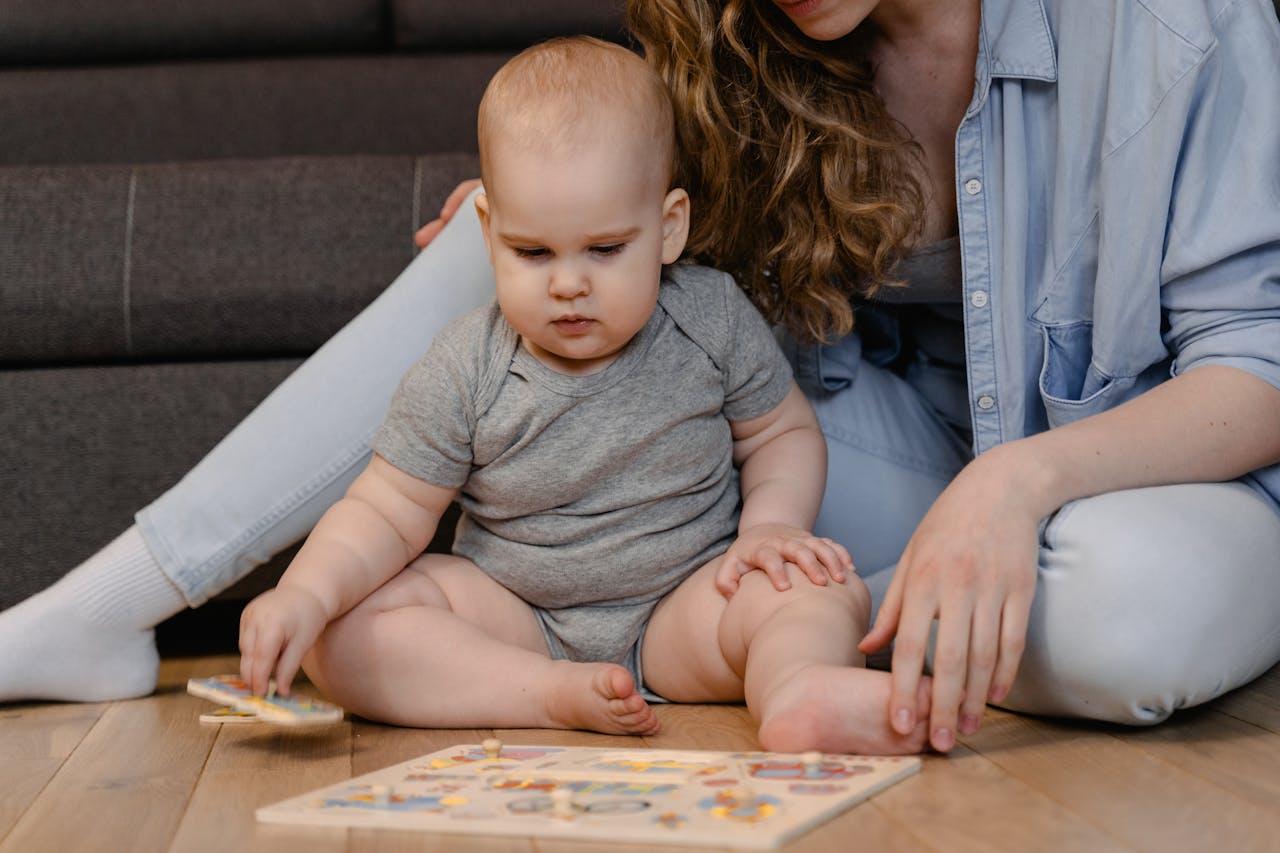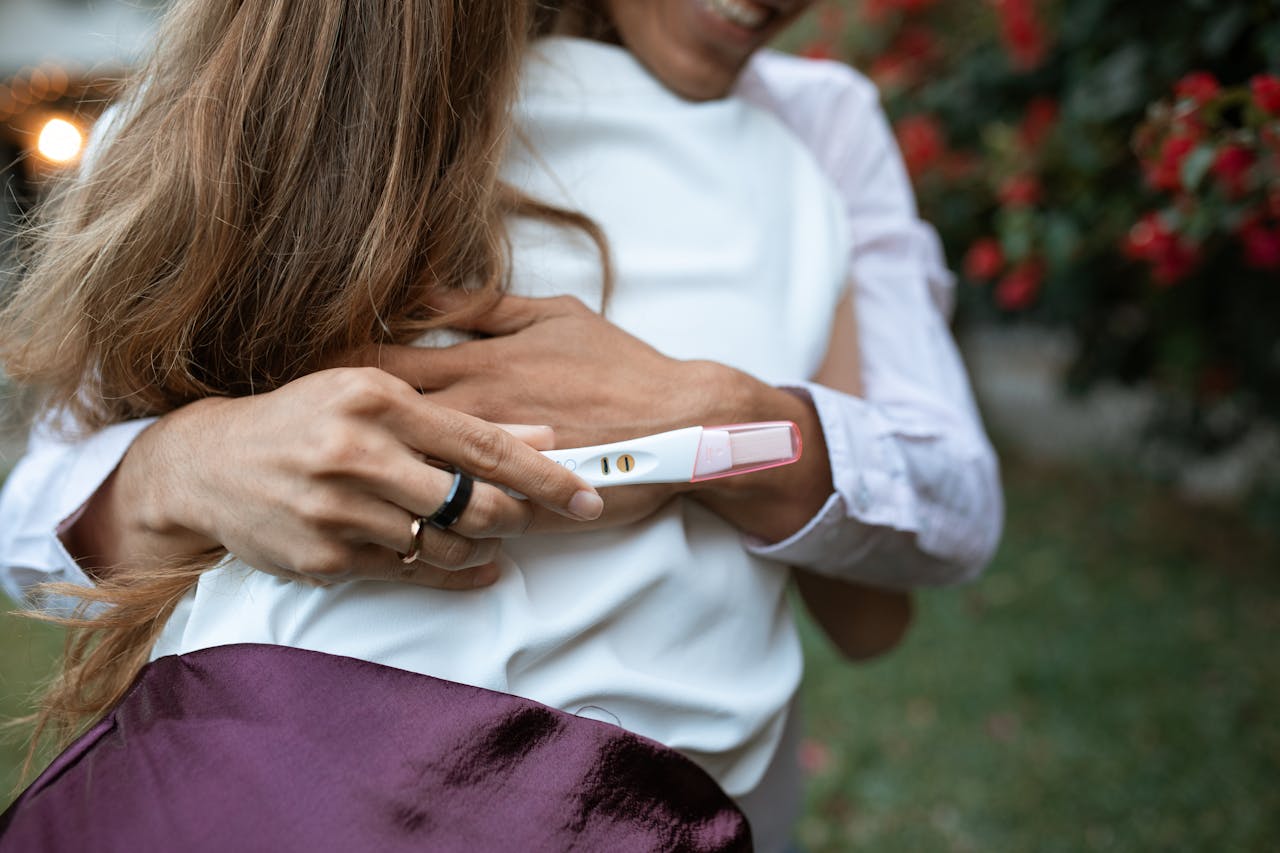If you’re a new parent, nothing is more adorable than your baby’s soft, delicate skin. So it can be a little alarming when you notice red or white bumps appearing on their cheeks, forehead, or chin. Don’t worry—you’re not alone. Many babies develop baby acne during the first few weeks of life, and the good news is: it’s completely normal and usually temporary. In this article, we’ll walk you through everything you need to know about how to get rid of baby acne—including what causes it, how long it lasts, what to do (and not do), and when to consult a doctor. This guide is written with real medical insights but in a gentle, parent-friendly tone. What Is Baby Acne? Baby acne, also known as neonatal acne, is a common skin condition that affects up to 20% of newborns. It usually appears as small red or white bumps or pimples, mostly on the face—especially the cheeks, nose, and forehead. Sometimes it can also appear on the neck, upper back, or chest. Key facts: It’s different from adolescent acne, as it’s not related to clogged pores or poor hygiene. What Causes Baby Acne? The exact cause of baby acne isn’t fully understood, but experts believe it is mostly due to hormones. During the final stages of pregnancy, a mother’s hormones pass to the baby through the placenta. These hormones can stimulate the baby’s sebaceous (oil) glands, causing acne-like breakouts. Other possible contributing factors include: 👶 Important: Baby acne is not caused by allergies, dirty skin, or poor hygiene. It’s a natural part of some babies’ development. According to the American Academy of Dermatology, baby acne is common and typically clears on its own without scarring. How Long Does Baby Acne Last? In most cases, baby acne resolves on its own within a few weeks to a few months without any treatment. Some babies have mild breakouts that clear up quickly, while others might have more noticeable spots that linger a bit longer. Typical duration: If the acne persists longer than that, or if it gets worse, it may be a sign of a different skin condition (like eczema or infantile acne). How to Get Rid of Baby Acne (Gently and Safely) While baby acne usually doesn’t need treatment, there are things you can do at home to help your baby’s skin heal naturally and comfortably. Here are the best tips for how to get rid of baby acne: 1. Keep Your Baby’s Skin Clean Use plain, lukewarm water to gently wash your baby’s face once a day. You can also use a mild, fragrance-free baby cleanser (approved by pediatricians). Avoid scrubbing or using any harsh washcloths. 🧼 Do this: 2. Avoid Lotions, Oils, and Adult Skincare Products It’s tempting to apply creams or ointments to “fix” the acne, but many products can clog your baby’s sensitive pores or make things worse. 🚫 Avoid: Stick to baby-safe products only if recommended by your pediatrician. 3. Dress Baby in Soft, Breathable Fabrics Clothing can sometimes irritate baby acne, especially if it’s rough or traps heat. Dress your baby in soft, breathable cotton fabrics and avoid tight-fitting clothes that rub against the face or chest. Also, wash all baby clothes, swaddles, and bedding in a fragrance-free, hypoallergenic detergent to reduce skin irritation. 4. Avoid Picking or Squeezing the Pimples Even though it may be tempting, never try to pop or squeeze your baby’s acne. This can lead to infection, irritation, or even scarring. Let the acne run its course, and remember—it bothers you more than your baby. You can learn more about proper infant skincare on HealthyChildren.org, a site backed by the American Academy of Pediatrics. What Not to Do Knowing what not to do is just as important as knowing what to do. Here are common mistakes parents make when trying to get rid of baby acne: Stick to gentle care and patience—most baby acne disappears with time and basic hygiene. When to See a Doctor Baby acne is usually nothing to worry about, but there are cases when you should check in with your pediatrician or a dermatologist. Call your doctor if: 💬 A quick visit can offer reassurance, and your doctor might suggest a mild topical cream if necessary. Other Skin Conditions That Look Like Baby Acne Because baby skin is sensitive, it’s common for new parents to confuse baby acne with other newborn skin conditions. If you’re unsure, it’s always best to check with a healthcare provider. If you suspect your baby has dry, red patches instead of acne, it may be eczema—learn more from the National Eczema Association. Here’s how to tell the difference: ✅ Baby Acne ❌ Milia ❌ Eczema ❌ Heat Rash If you’re unsure, it’s always best to check with a healthcare provider. Natural Remedies: Are They Safe? You may have heard of using breast milk, coconut oil, or witch hazel as remedies for baby acne. While some parents swear by these natural treatments, it’s important to be cautious. 👶 Bottom line: If you want to try a natural remedy, talk to your pediatrician first to make sure it’s safe. How to Support Your Baby’s Skin Long-Term Even after baby acne clears up, it’s important to protect your child’s delicate skin. Long-term skin care tips: Your baby’s skin is developing and adapting. With gentle care and patience, it will get stronger and clearer with time. Final Thoughts If you’re feeling stressed about your baby’s skin, know that you’re not alone. Baby acne is incredibly common, totally normal, and usually clears up on its own. While it may not be the picture-perfect baby face you imagined, it’s nothing to worry about. The best approach to how to get rid of baby acne is simply to keep your baby’s skin clean, avoid harsh products, and be patient. In a few weeks, you’ll likely see smooth, healthy skin return—and a happy baby who never even noticed the fuss. Parenthood comes with many little surprises, and baby acne is
Newborn Behaviour: What Every Parent Should Know
Bringing home a newborn is an exciting, emotional, and sometimes overwhelming experience. One of the biggest challenges new parents face is trying to understand what their baby is trying to tell them—through cries, facial expressions, and body language. Since newborns can’t talk, all their communication comes in the form of behaviour. Understanding newborn behaviour is key to meeting your baby’s needs, fostering a secure attachment, and easing your transition into parenthood. In this article, we’ll explore the most common behaviours newborns display, what they mean, and how you can respond effectively. What Is “Normal” Newborn Behaviour? Newborns (babies from birth to about 2 months) go through a massive adjustment from the womb to the outside world. Their actions may seem random at first, but they’re actually driven by basic needs: hunger, comfort, sleep, and bonding. Key newborn behaviours include: It’s important to remember that newborn behaviour varies from baby to baby. Some are calm and sleepy, while others are more alert and fussy. That said, most newborns follow certain patterns that help parents decode what’s going on. 1. Crying: Your Baby’s First Language Crying is a newborn’s main way to communicate. It doesn’t always mean something is wrong. Crying can indicate: Newborns typically cry 1 to 3 hours a day in the first few weeks. This is completely normal, though it can be tough for parents. How to respond: 🍼 Pro Tip: Over time, you’ll start to recognize different types of cries (e.g., hunger cry vs. pain cry). This helps you respond more confidently. 2. Sleeping Patterns: Why Newborns Wake Often Newborns don’t sleep like adults. Most sleep 14 to 17 hours a day, but in short bursts—usually 2–4 hours at a time. This fragmented sleep can feel exhausting for new parents. Why do newborns wake up so often? How to help your baby (and yourself) sleep better: 😴 Learn more about newborn sleep safety from the American Academy of Pediatrics. 3. Feeding Behaviour: Hungry or Just Comforting? Feeding is a major part of newborn behaviour, whether you breastfeed or bottle-feed. Most newborns eat 8 to 12 times in 24 hours. Signs your newborn is hungry: Newborns also suck for comfort, not just nutrition. This is totally normal and helps them feel secure. 🍼 Tip: Responsive feeding (feeding based on cues, not the clock) helps regulate appetite and build a strong bond. 4. Reflexes and Movements: Built-In Survival Tools Newborns are born with several natural reflexes. These are automatic behaviours that help them survive in the early weeks of life. Common newborn reflexes include: These reflexes are completely normal and gradually disappear as your baby’s brain matures. You might notice:Newborns also make jerky, twitchy movements—this is because their nervous system is still developing. As they grow, their movements become more controlled. 5. Bonding and Eye Contact: The Social Side of Newborns Although your newborn can’t talk or smile right away, they are already wired to connect with you. This bonding is essential for their emotional and cognitive development. Signs your baby is bonding with you: 👶 Research shows that face-to-face interaction with caregivers helps babies develop trust, emotional security, and even early language skills. 6. Startle and Overstimulation: Knowing Baby’s Limits Newborns have sensitive nervous systems. Too much noise, light, or handling can quickly overwhelm them. Signs of overstimulation: When this happens, give your baby a break. Take them to a quiet room, dim the lights, or swaddle them to help them feel safe and calm. 🧘 Remember: Newborns need downtime as much as they need stimulation. Gentle rhythms and quiet bonding are best in the early weeks. 7. Facial Expressions and Sounds Even though they don’t speak, babies use a range of facial expressions and vocalizations to communicate. You might notice: These little cues are part of how babies learn to interact. Responding to them with eye contact, gentle words, or soft touch teaches your baby that communication works. When to Be Concerned About Newborn Behaviour While most newborn behaviours are completely normal, it’s important to know when to seek help. Contact your pediatrician if: 🩺 Trust your instincts. If something doesn’t feel right, it’s always okay to ask a doctor or nurse. Supporting Healthy Newborn Behaviour: What Parents Can Do Final Thoughts Understanding newborn behaviour helps you feel more confident and connected in those intense first weeks of parenthood. Every baby is unique, but with patience, observation, and love, you’ll learn your baby’s cues—and how to respond to them in a way that nurtures their growth. You don’t need to be perfect. Just present, responsive, and loving. That’s what matters most. Quick Summary: Common Newborn Behaviours Behaviour What It Means How to Respond Crying Hunger, discomfort, tiredness Feed, change, soothe, cuddle Sleeping often Normal sleep pattern Let baby sleep on back, wake to feed Feeding frequently Growth and comfort needs Feed on demand, watch hunger cues Reflexes & movement Normal brain and body development Swaddle if needed, give tummy time Startling Sensitive nervous system Reduce noise, swaddle, hold baby Eye contact Bonding and emotional connection Talk and smile back, make time to connect Helpful Resources
10 Steps to More Effective Parenting
Parenting is a beautiful journey filled with joy, learning, and growth—but it’s also one of the most challenging roles you’ll ever have. As every child is different, there’s no “one-size-fits-all” method to raise them. However, by understanding the principles of effective parenting, you can foster a loving, respectful, and healthy relationship with your child that helps them thrive in life. Whether you’re a new parent or simply looking to improve your skills, this guide offers practical, real-world steps to becoming a more effective parent. 1. Understand Your Child’s Developmental Stage Effective parenting starts with understanding where your child is developmentally. A toddler’s tantrum, for example, isn’t just bad behavior—it’s often their way of expressing frustration due to limited language skills. Similarly, teenagers seeking independence isn’t rebellion; it’s part of their natural development. Why this matters: When you understand what’s normal for your child’s age, you can respond with empathy rather than frustration. 📚 Pro Tip: Learn about child development through trusted sources like the CDC’s Developmental Milestones or consult your pediatrician. 2. Create a Safe, Loving Environment Your home should be a place where your child feels safe, heard, and loved. Emotional safety is just as important as physical safety. This means being available, showing affection, and ensuring your child feels valued. What you can do: 🏡 A warm and structured home environment lays the foundation for trust, respect, and emotional well-being. 3. Practice Positive Discipline Discipline is not about punishment; it’s about teaching. Positive discipline helps your child learn appropriate behavior through guidance, not fear. Strategies for effective discipline: 💡 Example: Instead of yelling, try saying: “I see you’re upset. Let’s take a breath together and talk about what happened.” For more on this approach, visit Positive Discipline. 4. Be an Active Listener Effective parenting involves listening more than talking. When your child comes to you with a problem, resist the urge to immediately correct or fix. Instead, listen attentively and validate their feelings. How to practice active listening: 👂 Children who feel heard are more likely to open up, cooperate, and feel emotionally connected to their parents. 5. Model the Behavior You Want to See Kids are always watching. They absorb not just your words but your actions, reactions, and tone. If you want your child to be kind, respectful, and honest—you must model those traits yourself. Examples of modeling: Remember: You are your child’s first and most influential teacher. 6. Encourage Independence and Responsibility Fostering independence is a key part of effective parenting. Let your child make age-appropriate decisions and take responsibility for their actions. Age-appropriate ways to build independence: 🎯 Goal: Help your child build confidence, decision-making skills, and a sense of accountability. 7. Stay Consistent with Routines and Expectations Children thrive on predictability. Having clear rules and regular routines helps reduce anxiety and builds discipline. Tips for consistency: ⏱️ Bonus: Consistent routines also make transitions (like bedtime or leaving the park) easier. 8. Support Emotional Intelligence Helping your child recognize, understand, and manage their emotions is a cornerstone of effective parenting. Children with strong emotional intelligence tend to do better in school, relationships, and life. Ways to teach emotional intelligence: 📖 Consider using books or emotional learning games to build these skills, especially with younger children. 9. Limit Screen Time and Encourage Play While screens are part of modern life, too much screen time can negatively impact sleep, behavior, and academic performance. What research says: Encourage more play instead: 🎮 A balanced approach to screens promotes healthier development. 10. Take Care of Yourself Parenting can be exhausting, especially if you’re constantly pouring from an empty cup. Self-care isn’t selfish—it’s necessary. Simple self-care tips: 🧘 The more emotionally and physically healthy you are, the better parent you can be. Final Thoughts: No One Is Perfect Effective parenting isn’t about being perfect. It’s about showing up, learning as you go, and building a strong, loving connection with your child. Mistakes are part of the process—what matters is how you respond and grow from them. By incorporating these steps into your parenting journey, you’re already taking meaningful strides toward raising happy, resilient, and emotionally healthy children. Additional Resources To deepen your parenting skills, explore these trusted sites:
How to Burp a Newborn: A Complete Guide for New Parents
Bringing a newborn home is one of the most heartwarming experiences in life. Amidst all the cuddles and coos, feeding and burping quickly become routine tasks. One of the most frequently asked questions by new parents is: How to burp a newborn? This essential skill helps babies release air swallowed during feeding, preventing discomfort, spit-ups, and fussiness. In this comprehensive guide, we’ll walk you through why burping is important, different methods to try, when to burp, and helpful tips to make the process easier. We’ve also included credible outlinks for further reading to support your parenting journey. Why Do Newborns Need to Be Burped? During feeding, whether by breast or bottle, newborns tend to swallow air. This trapped air in their tiny stomachs can lead to gas, discomfort, and crankiness. Burping helps release this air, reducing the risk of spit-up and colic. Some babies need to be burped frequently, while others may not swallow as much air and require it less often. Learning to read your baby’s cues will help you determine what works best. Benefits of Burping a Newborn: For more on newborn digestion and feeding tips, visit HealthyChildren.org. When Should You Burp a Newborn? There is no universal rule for when to burp a baby, but general guidelines can help: Some babies may naturally release gas through burps without your help, but most will need gentle assistance. Best Positions for Burping a Newborn There are three primary burping positions that are safe and effective. You can try each one to see which works best for your baby. 1. Over-the-Shoulder Burp 2. Sitting on Your Lap 3. Lying on Your Lap For visual reference, check out the illustrated burping positions on The Bump. How Long Should You Try to Burp a Newborn? If your baby hasn’t burped after a few minutes in one position, try changing to another. Some babies take time, and others burp quickly. Keep sessions gentle and patient. Most newborns burp within 1 to 5 minutes, but every baby is different. If your baby seems content and doesn’t show signs of discomfort, it might be okay to move on. What If My Newborn Won’t Burp? Sometimes, even with the best techniques, your baby might not burp. Here’s what to do: 1. Try Different Positions Sometimes switching to another position helps. Go from over-the-shoulder to lying across your lap, for instance. 2. Give It a Minute Wait a few minutes, keeping the baby upright to allow gravity to assist. Try again after a short break. 3. Check for Discomfort If your baby is squirming, arching their back, or seems unsettled, a trapped burp might be the cause. Try again gently. For more tips on gas relief, see Cleveland Clinic’s Newborn Gas Guide. Should You Burp a Sleeping Baby? If your baby falls asleep mid-feed or immediately after, you can still try burping them gently. Hold them upright against your chest and pat or rub their back softly. Some babies will burp in their sleep and stay settled. If they don’t burp but are sleeping soundly and not showing signs of discomfort, it may be okay to let them sleep. Burping and Reflux: What You Need to Know Babies with acid reflux or gastroesophageal reflux disease (GERD) may need to be burped more frequently. Frequent, small burps during feeding can help reduce symptoms. If your baby is spitting up frequently or seems in pain during or after feedings, consult your pediatrician. Tips for Successful Burping Explore more baby care routines at WhatToExpect.com. When to Talk to a Pediatrician While burping is usually simple and effective, there are situations that require medical attention: Always trust your instincts as a parent. If something doesn’t feel right, reach out to your baby’s doctor. Final Thoughts Learning how to burp a newborn is an important part of early parenthood. With patience, practice, and a few different techniques, you’ll find what works best for your baby. Remember, every baby is different, and what works for one might not work for another. Trust yourself, keep things gentle, and lean on reliable sources and your pediatrician when needed. Additional Resources:
Newborn Wake Windows: Understanding Sleep Cues and Patterns
Navigating the first few weeks of your baby’s life can feel overwhelming, especially when it comes to sleep. One concept that helps many new parents is understanding “newborn wake windows”—the short spans of time a newborn can stay awake before needing to sleep again. Knowing and respecting these windows can help prevent overtiredness and support healthier sleep habits. In this guide, we’ll dive into what newborn wake windows are, why they matter, and how to use them to create a soothing sleep routine. We’ll also include helpful tips and credible resources to support your parenting journey. What Are Newborn Wake Windows? Wake windows refer to the amount of time a baby can stay awake between naps. For newborns (0–12 weeks old), these windows are very short—typically ranging from 30 to 90 minutes, depending on the baby’s age and temperament. Average Wake Windows by Age: Every baby is different, so some variation is normal. Observing your baby’s sleep cues is the best way to adjust the wake windows to their needs. Why Wake Windows Matter for Newborns Respecting wake windows can make a significant difference in your baby’s mood, feeding success, and overall well-being. Newborns become overtired quickly, and once they pass their ideal wake window, falling asleep becomes harder. Benefits of Following Wake Windows: How to Spot Sleep Cues Sleep cues are signs your baby is getting tired. Learning to recognize these early can help you put your baby to sleep before they become overtired. Common Sleep Cues: Once you notice these signs, begin your soothing routine immediately to catch your baby’s ideal sleep window. Sample Daily Schedule Based on Wake Windows Here’s a rough example of a day for a 6-week-old baby (wake windows around 60 minutes): Remember, newborns typically need 14–17 hours of sleep in a 24-hour period, including frequent naps and night sleep with feedings in between. Tips for Managing Newborn Wake Windows 1. Use a Timer Start a timer when your baby wakes to keep track of their current wake window. 2. Watch the Baby, Not the Clock While timers help, your baby’s cues should always take priority. 3. Create a Pre-Nap Routine Doing a quick calming routine before each nap (diaper change, swaddle, lullaby) can signal it’s time for sleep. 4. Avoid Overstimulation Too much noise, light, or activity can shorten a baby’s wake window. Keep stimulation gentle and age-appropriate. 5. Use Wake Windows Flexibly Growth spurts, illness, and developmental changes may temporarily alter your baby’s sleep needs. Common Challenges and Solutions My Baby Won’t Nap Within the Wake Window Try adjusting the soothing time or reduce stimulation during wake time. Ensure they’re not staying awake too long. My Baby Naps Too Long Newborns can sometimes nap for 2–3 hours. If this happens late in the day, it may affect nighttime sleep. Gently wake them if needed. What If the Wake Window Is Missed? If your baby gets overtired, try calming techniques like rocking, swaddling, or white noise to help them settle. Resources and Further Reading Final Thoughts Understanding newborn wake windows can make early parenting less stressful and more predictable. When you align sleep with your baby’s natural rhythms, you’ll likely see better sleep quality, reduced fussiness, and a happier baby overall. Always remember, no schedule is perfect. Flexibility, patience, and attentiveness are key. Use wake windows as a helpful guide, not a strict rule. By tuning into your baby’s unique needs and respecting their sleep cues, you’ll be on the path to establishing healthy sleep habits from the start.
How To Create Your Birth Plan Template
Bringing a new life into the world is one of the most empowering and transformative experiences a person can have. While every birth is unique and unpredictable to some extent, having a birth plan template can provide clarity, reduce anxiety, and foster communication between you and your healthcare team. In this article, we will walk you through how to create your personalized birth plan template, what key elements to include, and why it’s an important step in your pregnancy journey. What is a Birth Plan? A birth plan is a written document that outlines your preferences for labor and delivery. It communicates your wishes to your care providers, including doctors, midwives, and nurses. While flexibility is key—as labor doesn’t always go according to plan—this document helps ensure your voice is heard and respected during one of the most intimate moments of your life. Why Do You Need a Birth Plan Template? Using a birth plan template makes the process of creating your plan more manageable. It offers a structured format to consider different aspects of childbirth you might not have thought of. It also encourages early discussions with your healthcare provider about your preferences, making it easier to address potential concerns before labor begins. Key Elements to Include in a Birth Plan Template Here are the essential components your birth plan template should cover: 1. Basic Information 2. Labor Preferences 3. Delivery Preferences 4. Medical Interventions 5. Post-Birth Care for Baby 6. Unexpected Situations 7. Additional Notes Tips for Creating a Flexible Birth Plan While it’s important to communicate your preferences, it’s equally vital to remain flexible. Birth is unpredictable, and rigid expectations can lead to disappointment. Keep your birth plan short (one to two pages) and use bullet points for clarity. Talk with your healthcare provider about your birth plan early in your third trimester. Some hospitals have their own birth plan templates or policies that might influence your preferences, so it’s good to compare your plan with what’s allowed or recommended. Tools and Resources to Help You If you’re not sure where to begin, several reputable sources offer free and customizable birth plan templates: These resources provide guided checklists and help you think through your choices without feeling overwhelmed. Sample Birth Plan Template Here’s a quick example to get you started: Name: Jane DoePartner: John DoeHospital: City General HospitalDue Date: September 15, 2025 Labor Preferences: Delivery Preferences: Post-Birth: If C-Section Is Needed: Final Thoughts Creating a birth plan template is not about scripting your delivery; it’s about preparing for it. Your birth plan gives you a voice in the process, promotes informed decision-making, and ensures that you and your healthcare team are on the same page. Remember, your comfort, safety, and well-being—and that of your baby—are the ultimate priorities. Stay informed, be flexible, and trust yourself. You’ve got this! For more pregnancy tips and evidence-based guidance, check out resources like What to Expect and Lamaze International.
When to Transition to Toddler Bed: A Guide for Parents
Transitioning your child from a crib to a toddler bed is a significant milestone for both child and parent. It signals the move from infancy to toddlerhood and introduces newfound independence. However, knowing when to transition to a toddler bed can be confusing. Timing, readiness, and safety are all crucial factors. This guide will help you determine the right time and approach to ensure a smooth and safe transition. Understanding Toddler Bed Readiness The age at which children transition from a crib to a toddler bed varies widely. Most children make the switch between 18 months and 3.5 years old. There is no single “perfect” age, but rather cues and circumstances that indicate your child is ready. Signs Your Child Is Ready Choosing the Right Toddler Bed Once you decide it’s time to transition, choosing the right toddler bed is essential. Here are the main options: Types of Toddler Beds Safety Considerations Preparing for the Transition Talk About the Change Start by talking to your toddler about the change. Read books about moving to a big kid bed and explain why the transition is happening. Involve Your Child Let your child help pick out the new bed or bedding. This gives them a sense of control and excitement about the new arrangement. Maintain a Bedtime Routine Stick to your usual bedtime routine to create consistency. Familiar activities like bath time, storytime, and cuddles will help them adjust more easily. Tips to Make the Transition Easier 1. Start with Naps If your child is hesitant, start with daytime naps in the toddler bed. Once they’re comfortable, transition to nighttime. 2. Use Positive Reinforcement Praise and reward your child for sleeping in their new bed. Sticker charts or small incentives can be effective. 3. Stay Calm During Setbacks It’s common for toddlers to resist or test boundaries during this transition. Stay patient, calm, and consistent. 4. Be Consistent Avoid going back and forth between crib and bed. Consistency helps reinforce the change. Common Challenges and Solutions Trouble Staying in Bed Some toddlers may get up repeatedly. You can: Fear of the New Bed Introduce the bed slowly and stay nearby for the first few nights. A nightlight or comfort object may help ease anxiety. Safety at Night Childproof the room as your toddler may now have the freedom to wander. Use safety gates, outlet covers, and secure heavy furniture. Special Circumstances Transitioning Due to a New Sibling If you’re making the change because a new baby is on the way, plan ahead. Transition at least 6-8 weeks before the baby arrives to avoid the child associating the change with the new sibling. Twins or Multiple Toddlers For families with twins, transitioning them together can work well. Keep beds close initially to provide comfort. FAQs About Toddler Bed Transition Q: What age is too early to transition?A: Most experts recommend waiting until at least 18 months, unless safety is a concern. Q: What if my toddler won’t stay in bed?A: Use calm but firm routines, and be consistent. Most toddlers adjust within a few weeks. Q: Should I keep the crib in the room during the transition?A: It depends on your child. Some benefit from having the crib visible initially; others may find it confusing. Final Thoughts: When to transition to a toddler bed Deciding when to transition to a toddler bed involves understanding your child’s development, behavior, and safety needs. Each child is unique, and there’s no universal timeline. With preparation, patience, and a positive approach, the switch can be a smooth and exciting step in your child’s growth. Remember: this is just another phase of growing up, and with your support, your toddler will thrive. If you’re currently considering making the transition, trust your instincts, look for readiness signs, and take the leap when your family feels ready. A good night’s sleep in a safe, comfortable bed is just around the corner!
Early Childhood Education: Building the Foundation for Learning
Early childhood education (ECE) plays a critical role in a child’s cognitive, emotional, and social development. Often defined as the period from birth to eight years old, this stage of education lays the groundwork for future academic success and overall well-being. With increasing awareness about the importance of early learning, parents and educators are more focused than ever on providing quality educational experiences in a child’s formative years. In this article, we will explore what early childhood education is, its benefits, key components, current trends, and tips for parents to support their child’s early learning journey. What Is Early Childhood Education? Early childhood education refers to the structured and informal teaching that children receive before they enter formal schooling (kindergarten through third grade). It includes preschool programs, daycare centers with educational elements, and activities parents and caregivers do at home to foster learning. ECE focuses on helping children develop foundational skills such as: The Benefits of Early Childhood Education 1. Brain Development:During the early years, a child’s brain develops more rapidly than at any other time in life. Quality ECE programs stimulate brain activity and help children form neural connections that influence lifelong learning. 2. Social Skills:By interacting with peers and adults in structured settings, children learn to share, take turns, follow directions, and resolve conflicts—key skills that benefit them in school and beyond. 3. Academic Readiness:Children who attend early education programs often perform better academically. They develop literacy and numeracy skills that ease the transition into formal schooling. 4. Emotional Regulation:ECE helps children learn how to understand and manage their emotions, improving their self-control and resilience. 5. Long-Term Impact:Research shows that children who receive high-quality early education are more likely to graduate from high school, pursue higher education, and have higher earning potential as adults. Key Components of Effective Early Childhood Education 1. Qualified Educators:Skilled and passionate teachers are the backbone of successful early education programs. They use age-appropriate teaching strategies and create safe, engaging environments. 2. Play-Based Learning:Play is not just fun; it’s educational. Through play, children explore their environment, develop creativity, and learn problem-solving. 3. Parent and Family Involvement:Parental engagement reinforces learning at home and builds a strong connection between families and educators. 4. Inclusive and Diverse Curriculum:ECE should respect cultural, linguistic, and developmental differences, ensuring that all children feel valued and supported. 5. Safe and Nurturing Environment:Physical and emotional safety is essential. Children thrive in environments where they feel secure and cared for. Current Trends in Early Childhood Education 1. Technology Integration:More programs are incorporating digital tools to enhance learning, including interactive games, tablets, and educational apps. However, balance and screen time limits are important. 2. Emphasis on Social-Emotional Learning (SEL):Programs are placing more focus on teaching empathy, emotional awareness, and cooperation. 3. STEAM Education:Early exposure to Science, Technology, Engineering, Arts, and Math (STEAM) activities helps develop curiosity and problem-solving skills. 4. Outdoor and Nature-Based Learning:Spending time in nature boosts physical health, creativity, and appreciation for the environment. 5. Multilingual Education:Introducing additional languages at a young age can enhance cognitive development and communication skills. How Parents Can Support Early Childhood Education 1. Read Together Daily:Reading to your child promotes language development, imagination, and bonding. Make it a part of your daily routine. 2. Encourage Curiosity:Answer your child’s questions patiently and involve them in everyday learning activities, such as cooking or gardening. 3. Set a Routine:Consistent routines help children feel secure and develop time management skills. 4. Limit Screen Time:Provide interactive, hands-on learning instead of passive screen time. 5. Communicate With Educators:Stay informed about your child’s progress and collaborate with teachers to address any concerns. Conclusion Early childhood education is a vital investment in a child’s future. It supports brain development, fosters emotional and social intelligence, and lays the groundwork for academic success. With the right combination of skilled educators, supportive families, and engaging learning environments, children can thrive and reach their full potential. Whether at home or in a structured setting, every experience in a young child’s life contributes to who they will become. As awareness grows, the focus must remain on providing inclusive, high-quality early learning opportunities for all children. By understanding and supporting early childhood education, parents and educators play a powerful role in shaping the next generation of thinkers, creators, and compassionate individuals.
Digital Pregnancy Test: A Modern Approach to Early Pregnancy Detection
Finding out whether you’re pregnant can be one of the most emotional and life-changing moments in your life. Thanks to modern technology, the process has become more accessible, accurate, and user-friendly than ever before. One of the most popular innovations in home pregnancy testing is the digital pregnancy test. But how does it work, and why might it be the right choice for you? This article will dive into everything you need to know about digital pregnancy tests, from how they work to their advantages and limitations. What Is a Digital Pregnancy Test? A digital pregnancy test is a modern version of the traditional over-the-counter pregnancy test. Unlike analog tests that require interpreting colored lines, digital tests display results in words—usually “Pregnant” or “Not Pregnant.” This simplicity helps reduce the chance of misreading the result. The digital test works the same way as traditional pregnancy tests: it detects the presence of the hormone human chorionic gonadotropin (hCG) in urine. hCG is produced by the placenta shortly after a fertilized egg attaches to the uterine lining, which typically occurs six to twelve days after ovulation. How Does a Digital Pregnancy Test Work? Digital pregnancy tests contain a small strip inside, similar to a traditional test, that reacts with hCG in urine. The difference lies in the technology that reads the strip and converts the result into a digital display. Here’s a step-by-step breakdown: Some advanced models even estimate how many weeks have passed since ovulation, giving results such as “Pregnant 1-2 weeks.” Advantages of Using a Digital Pregnancy Test 1. Clear Results The biggest advantage is clarity. There’s no need to interpret faint lines or wonder whether a result is positive. The screen tells you outright. 2. Higher Sensitivity Digital tests often offer high sensitivity to hCG, sometimes detecting it earlier than some analog tests. Many are capable of providing accurate results even four to five days before a missed period. 3. Convenient and Easy to Use These tests are user-friendly with minimal room for user error. The directions are usually simple, and the results appear in under three minutes. 4. Additional Features Some digital tests come with features like a countdown timer or a blinking symbol that lets you know the test is processing. Disadvantages to Consider 1. Cost Digital pregnancy tests are typically more expensive than traditional ones. While a basic analog test may cost a few dollars, digital tests can range between $10 to $25 for a single-use pack. 2. Environmental Waste Due to electronic components, digital tests create more waste compared to paper-strip alternatives. 3. Same Core Functionality Despite the advanced display, the internal chemical test is nearly the same as any regular pregnancy test. You’re essentially paying for easier interpretation and added convenience. Best Time to Take a Digital Pregnancy Test The best time to take a digital pregnancy test is after your missed period. However, if you’re using a test labeled as “early detection,” you can take it as soon as six days before your expected period. For the most accurate result: Accuracy of Digital Pregnancy Tests Most digital pregnancy tests claim around 99% accuracy when used from the day of your expected period. However, accuracy may drop slightly if taken too early. False negatives are more common than false positives. This can occur due to testing too early, diluted urine, or miscalculating your ovulation date. If you receive a negative result but still suspect you’re pregnant, wait a few days and test again. Top Digital Pregnancy Test Brands in 2025 1. Clearblue Digital Pregnancy Test 2. First Response Digital Pregnancy Test 3. E.P.T. Digital Pregnancy Test Always check the expiration date and ensure you follow the instructions carefully. What to Do After a Positive Test If your digital test result says “Pregnant”: If your result is negative and your period doesn’t start within a week, retest or consult a healthcare provider. Are Digital Pregnancy Tests Worth It? While digital pregnancy tests offer enhanced clarity and ease of use, they may not necessarily be more accurate than traditional tests. However, for those who value certainty and simplicity, they can be well worth the extra cost. People often choose digital pregnancy tests for: Final Thoughts A digital pregnancy test offers a reliable, easy-to-understand way to confirm pregnancy from the comfort of your home. Its advanced technology ensures accurate readings and minimizes the stress and confusion that can come with analog tests. Whether you’re trying to conceive or are concerned about an unexpected pregnancy, digital pregnancy tests provide a modern, efficient, and dependable solution. Always remember to follow up with your healthcare provider for confirmation and next steps. In 2025, technology continues to make home health care more accessible and precise. A digital pregnancy test is a prime example of how innovation can offer convenience and reassurance during life’s most important moments.
Can Pregnant Women Eat Pineapple? A Comprehensive Guide to Benefits and Myths
Pregnancy is a time of joy, anticipation, and many questions about what’s safe to eat. One fruit that often sparks concern is pineapple. You may have heard conflicting advice, leaving you wondering: can pregnant women eat pineapple? This article will explore the facts, benefits, potential risks, and misconceptions surrounding pineapple consumption during pregnancy, offering SEO-optimized and real insights for expectant mothers. Can Pregnant Women Eat Pineapple? The Short Answer Yes, pregnant women can eat pineapple in moderate amounts. Despite popular myths, eating pineapple does not induce labor or cause miscarriage in a healthy pregnancy. In fact, pineapple is rich in essential vitamins and nutrients that can support maternal health. Nutritional Benefits of Pineapple During Pregnancy Pineapple is not only delicious and refreshing, but it also provides key nutrients that benefit both the mother and the developing baby. 1. Rich in Vitamin C Vitamin C boosts the immune system, aids in iron absorption, and promotes healthy skin and tissue development. 2. Contains Bromelain Bromelain is an enzyme found in fresh pineapple that may aid digestion and reduce inflammation. However, the concentration in the edible part of the fruit is low and considered safe when consumed as part of a balanced diet. 3. High Water Content Hydration is essential during pregnancy. Pineapple’s high water content can help prevent dehydration, especially in warmer months. 4. Supports Digestion Pineapple is a good source of dietary fiber, which can help reduce constipation—a common issue during pregnancy. Common Myths About Pineapple and Pregnancy Myth 1: Pineapple Causes Miscarriage This widespread belief likely stems from the presence of bromelain. While large doses of bromelain supplements are not recommended, the amount in pineapple flesh is minimal and not enough to trigger uterine contractions. Myth 2: Pineapple Induces Labor Some women believe eating pineapple late in pregnancy can start labor. However, there is no scientific evidence supporting this claim. Labor begins when the body is ready, not because of a single food. Myth 3: Pineapple Is Too Acidic Pineapple’s natural acidity might cause heartburn in some pregnant women, particularly in the third trimester. If this is the case, it’s best to limit intake or eat it with other foods to reduce discomfort. How Much Pineapple Can Pregnant Women Eat? Moderation is key. A few slices of fresh pineapple or a small bowl a few times per week is generally safe and healthy. Overconsumption could lead to: Safe Ways to Eat Pineapple During Pregnancy Fresh Pineapple Choose ripe, fresh pineapple for the highest nutritional value. Cut it into small chunks and enjoy it on its own or in fruit salads. Smoothies Blend pineapple with other fruits like banana and spinach for a nutrient-rich smoothie. Grilled or Roasted Grilling brings out the fruit’s natural sweetness. Pair it with lean meats or serve as a dessert. Juicing (In Moderation) While pineapple juice is tasty, it’s best to drink in moderation due to high sugar content and lack of fiber. When to Avoid or Limit Pineapple If You Have Gestational Diabetes Pineapple has a moderate glycemic index. If you have gestational diabetes, consult your doctor before consuming it regularly. If You Have Severe Heartburn or Acid Reflux In the third trimester, some women experience heightened sensitivity to acidic foods. Limit pineapple if it causes discomfort. Allergic Reactions Though rare, some people may be allergic to pineapple. Symptoms include itching, swelling, or difficulty breathing. Seek immediate medical attention if this occurs. Alternatives to Pineapple During Pregnancy If pineapple doesn’t sit well with you, consider other vitamin C-rich fruits such as: These fruits offer similar benefits and can be easier on sensitive stomachs. Expert Opinions Obstetricians and dietitians generally agree that pineapple is safe for pregnant women when consumed in normal food amounts. The myth of it causing miscarriage or early labor is not backed by scientific evidence. Dr. Laura Riley, a maternal-fetal medicine expert, states, “There is no solid data that links pineapple to labor induction or miscarriage. Enjoy it in moderation like any other fruit.” Key Takeaways Final Thoughts Pineapple can be a delicious and nutritious part of a pregnancy diet. While it’s surrounded by myths, the truth is that eating moderate amounts of pineapple is both safe and beneficial for most pregnant women. As with any food, pay attention to how your body reacts, and consult with your healthcare provider if you have any concerns. Looking for more pregnancy-safe foods or tips? Explore our blog for trusted guidance throughout your parenting journey!










